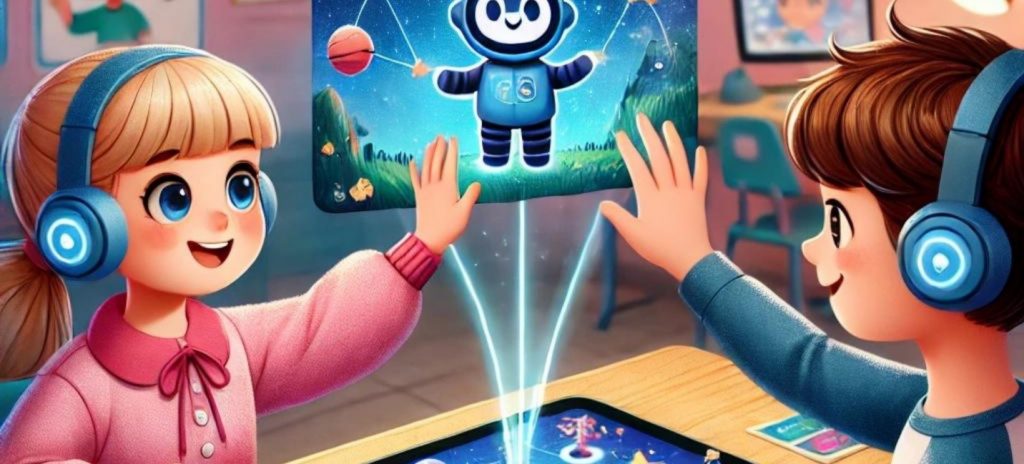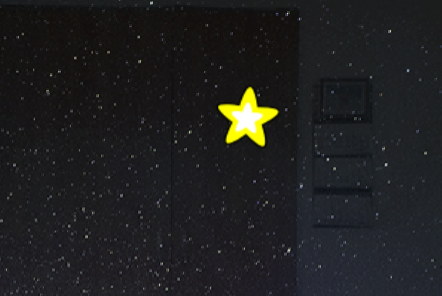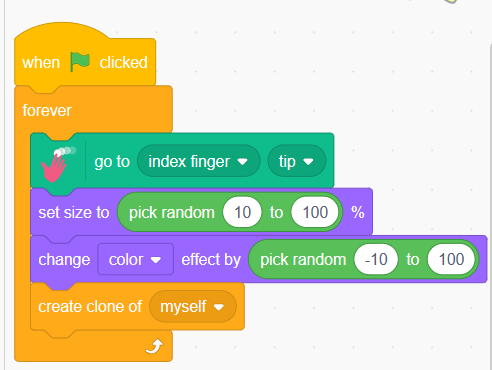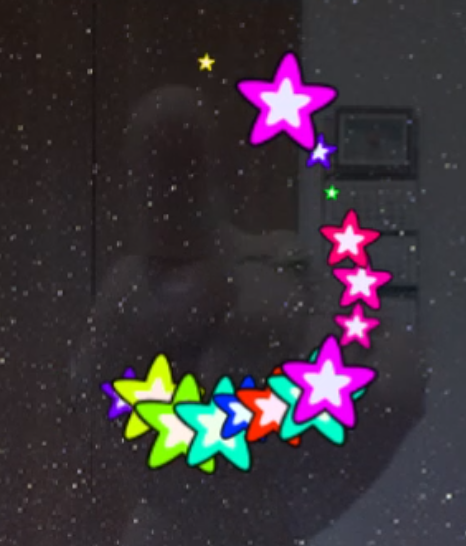In today’s rapidly evolving technological landscape, it’s essential to equip children with the skills they need to thrive in the future. At SkoolOfCode, we’re passionate about nurturing young minds and empowering them with the tools to innovate and create in the digital world.
Scratch is one such tool that has revolutionized how children learn to code. Scratch has emerged as powerful tools for introducing young learners to programming concepts in a fun and interactive way. However, with the rise of artificial intelligence (AI), there is a unique opportunity to enhance the learning experience on platforms like Scratch. By leveraging AI, educators can provide personalized guidance, foster creativity, and empower students to explore coding in deeper and more meaningful ways.
Combining the creative potential of Scratch with the power of Artificial Intelligence (AI) opens up endless possibilities for our students to explore, experiment, and invent. In this blog, we’ll delve into the fascinating realm of Scratch with AI, highlighting how it fosters creativity, critical thinking, and problem-solving skills in our students.
Scratch: A Gateway to Creativity
Scratch, developed by the MIT Media Lab, is a block-based visual programming language designed specifically for children. It provides a user-friendly interface where students can drag and drop blocks to create animations, games, stories, and interactive art. Scratch’s intuitive nature removes the barriers to entry, allowing even young learners to express their creativity through coding.
At SkoolOfCode, we recognize Scratch as a powerful educational tool that not only teaches coding concepts but also encourages collaboration, experimentation, and computational thinking. Our students start their coding journey with Scratch, learning fundamental programming concepts such as loops, conditionals, variables, and events playfully and engagingly.
Artificial Intelligence( AI) :
Artificial Intelligence (AI) refers to the simulation of human intelligence in machines, enabling them to perform tasks that typically require human cognition. It encompasses various techniques such as machine learning, natural language processing, and computer vision. AI systems analyze vast amounts of data to recognize patterns, make predictions, and adapt to new information autonomously. From virtual assistants like Siri to self-driving cars and recommendation algorithms, AI permeates modern technology, enhancing efficiency and innovation across industries. While AI continues to evolve, ethical considerations regarding its impact on society, privacy, and job displacement remain crucial aspects of its development and deployment.
Integrating AI into Scratch
The integration of AI into Scratch amplifies its potential and opens new avenues for exploration. By incorporating AI extensions and plugins, students can imbue their Scratch projects with intelligent behaviors, machine learning algorithms, and natural language processing capabilities.
For example, students can use AI algorithms to create chatbots that interact with users, image recognition models that identify objects in photos or even predictive analytics systems that forecast outcomes based on data inputs. These projects not only showcase the technical prowess of our students but also instill in them a deep understanding of AI concepts and applications.
Benefits of Scratch with AI
The fusion of Scratch with AI offers numerous benefits to our students:
- Enhanced Creativity: AI empowers students to create dynamic and interactive projects that respond intelligently to user input, fostering creativity and imagination.
- Real-World Relevance: By working on AI-powered projects, students gain practical experience in cutting-edge technologies that are shaping our world, preparing them for future careers in STEM fields.
- Critical Thinking Skills: Designing AI algorithms requires critical thinking, problem-solving, and algorithmic reasoning, skills that are essential for success in the digital age.
- Collaboration and Communication: Collaborative AI projects encourage students to work together, share ideas, and communicate effectively, promoting teamwork and social skills.
- Personalized Learning: With Scratch and AI, students can explore topics of interest, experiment with different AI techniques, and personalise their learning journey according to their interests and abilities.
Methods for Collaboration:
- AI-Powered Teaching and Feedback:
At SkoolOfCode, we believe that Scratch with AI is more than just a learning tool—it’s a catalyst for innovation, creativity, and empowerment. By embracing this fusion of technology and creativity, we’re equipping our students with the skills and mindset they need to thrive in a rapidly evolving world.
As our students continue to push the boundaries of what’s possible with Scratch and AI, we’re excited to see the incredible projects they’ll create and the impact they’ll make on the world around them. Together, we’re shaping the future—one line of code at a time.
- Natural Language Processing (NLP) Chatbots: Integrate NLP chatbots into the Scratch interface to provide students with instant assistance and support. Students can ask questions, request explanations, or seek guidance on coding challenges, and the chatbot can respond with helpful resources or explanations.
- Machine Learning for Project Recommendations: Implement machine learning algorithms to analyze students’ interests, preferences, and skill levels and recommend Scratch projects that align with their individual learning goals. This can help students discover new project ideas and explore different programming concepts.
- AI-Powered Code Generation: Explore the use of AI to generate code snippets or templates that students can incorporate into their Scratch projects. This can help students learn new coding techniques and streamline the development process for more complex projects.
Scratch projects with AI concepts
- Chatbot: Create a simple chatbot using Scratch where students can interact with a character on the screen. They can program responses to specific questions or keywords, giving the illusion of a conversation.
- Image Recognition Game: Develop a game where students can upload or draw pictures, and the program uses AI to recognize what the picture represents. For example, they could create a game where they draw animals, and the AI guesses which animal it is.
- Voice Recognition: Build a project where students can speak commands, and the program responds accordingly. They can program the AI to recognize specific phrases or words and execute actions in response.
- Predictive Text: Create a project where students type sentences, and the program predicts the next word or completes the sentence based on the context. This introduces the concept of predictive text and basic natural language processing.
- Virtual Pet with Emotion Recognition: Design a virtual pet game where students take care of a character on the screen. Incorporate emotion recognition AI to allow the pet to react to the player’s actions or mood.
- Gesture Recognition Game: Develop a game where students can use gestures or hand movements to control characters or objects on the screen. They can program the AI to recognize specific gestures and respond accordingly.
- Music Composition: Build a project where students can compose music using AI. They can program the AI to generate melodies or harmonies based on user input or predefined patterns.
- Sentiment Analysis: Create a project where students can input text, and the program analyses the sentiment (positive, negative, neutral) using AI. This could be used for analyzing short stories, poems, or even social media posts.
These projects provide a fun and engaging way for young students to learn about AI concepts while experimenting with Scratch. They encourage creativity, problem-solving, and critical thinking skills, all while introducing them to the exciting world of artificial intelligence.
Get ready for a thrilling journey with ‘Star Studded Sky,’ an interactive Scratch game using a hand sensor extension that makes learning AI concepts fun and educational for kids.

Here’s a basic outline of how you could create a game where the player clones a star sprite using a hand sensor:
1. Set up the Stage:
Open this link https://playground.raise.mit.edu/
2. Create the Star Sprite:
Choose the star sprite from the Scratch library or draw your own.
Add some scripts to the star sprite to make it interactive. For example, you could make it move when certain keys are pressed or when clicked.
3. Choose a backdrop for your game:
Create a backdrop or choose a backdrop like night sky for your game

4. Add the Hand Sensing Extension:
Go to the Extensions menu and choose “Add Extension.”

5. Add the Code:

Add event blocks to detect when the hand sensor is activated. When the hand sensor is activated, use a “clone” block to create a new clone of the star sprite. Position the clone randomly on the stage. The clones get deleted also after some specific time .
6. Testing and Debugging:
Test your game to make sure everything works as intended.
Debug any issues and make adjustments as needed.
7. Final Touches:
Add sound effects or background music to enhance the gaming experience.
Consider adding additional features or challenges to make the game more engaging.
8. The Output

Remember to encourage creativity and experimentation while creating the game. This project offers an opportunity for kids to explore coding concepts while having fun playing the game they’ve created themselves.
Conclusion:
The collaboration between AI and Scratch holds tremendous potential for transforming the way children learn to code. By harnessing the power of AI, educators can create a more personalised, engaging, and effective learning experience for students on platforms like Scratch. By incorporating AI-powered tutorials, chatbots, project recommendations, and code generation tools, educators can empower students to explore their creativity, develop critical thinking skills, and become proficient coders. With the right combination of AI technologies and educational strategies, we can inspire the next generation of innovators and problem solvers to thrive in the digital age.
At online coding classes for kids at SkoolOfCode, we recognize the importance of leveraging cutting-edge technologies like AI to enhance the learning experience for our students. Through our collaboration with Scratch and other innovative platforms, we are committed to providing quality coding education that empowers children to succeed in an increasingly technology-driven world. Join us on this exciting journey of exploration, creativity, and learning at Skoolofcode, where every child has the opportunity to unleash their full potential.
By – Mehak Dabra, Head of Scratch and DA and an educator at SkoolOfCode with a degree in Masters of Computer Application . She enjoys teaching and being with the young minds.

